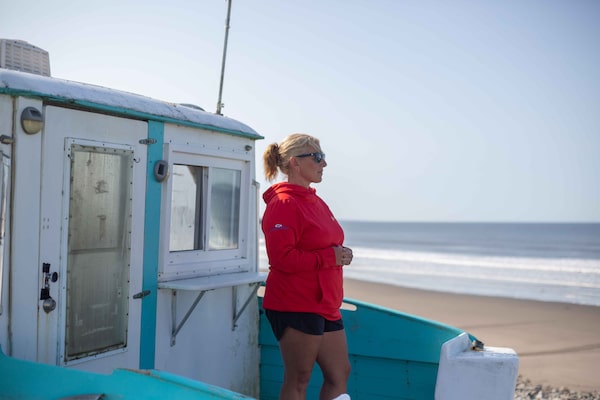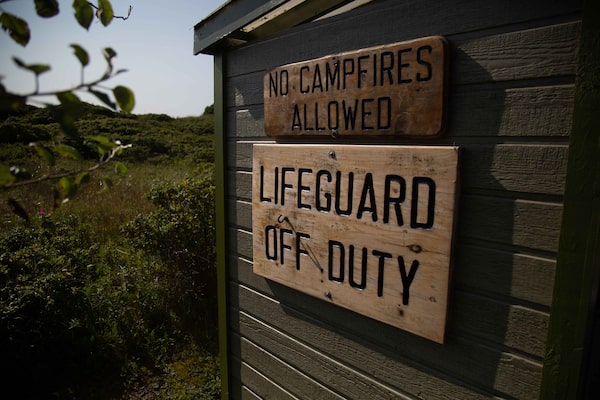
Jennifer Hood at Mavillette Beach Provincial Park, in the Yarmouth and Acadian Shores region, N.S., on Sept. 1.Meagan Hancock/The Globe and Mail
It was a drizzly Sunday morning, the third and final day of the Canadian Surf Lifesaving Championships, being held 40 minutes east of Halifax. Lifeguards from across the country were competing in 90-metre beach sprints when supervisor Jennifer Hood spotted it – something black in the water near the end of Rainbow Haven Beach, about 200 metres offshore. Upon closer look, she saw that it was a dorsal fin slicing through the water.
Ms. Hood, 51, who has worked as a lifeguard for almost three decades, at first wondered if it might be an ocean sunfish, a huge but docile species whose dorsal fins are a common sight as they mosey along the surface. But this animal’s fin skimmed the water continuously, right through a heavy current. “No, it is definitely a shark,” Ms. Hood recalled thinking at the time. She grabbed her megaphone.
“Can I have your attention, please,” she said. “We have a fin sighting, so please don’t go into the water for the next two hours.”
It could have been mayhem – a real-life “get out of the water” scene from the 1975 film Jaws – but under the cool grey skies of that morning the beach was occupied solely by dog walkers and other lifeguards, who, like Ms. Hood, aren’t easily rattled.
“It’s nothing to panic about, really,” said Ms. Hood, who manages lifeguards patrolling beaches on the Nova Scotia’s southwest shore, a popular summer and autumn feeding ground for great white sharks, a top predator that – rightly or wrongly – will always be associated with the terrifying movie. “The ocean is full of sharks, and they rarely come close to shore, but oftentimes they’re there and we just don’t see them.”
On average there are three to four reports of fin sightings off the beaches patrolled by lifeguards in the province each year, said Paul D’Eon, the special projects director for the Nova Scotia Lifeguard Service. “It’s occasional. … It’s a little strange to have it in that far because there’s a rock reef that protects the beach and there’s only a small space a fish like that could swim in,” he said, referring to the sighting at Rainbow Haven Beach.

Ms. Hood was working at the Canadian Surf Lifesaving Competition at Rainbow Haven Beach near Halifax when she spotted the raised fin of a white shark in the water.Meagan Hancock/The Globe and Mail
In the 51 years that the province’s beaches have been supervised, Mr. D’Eon said, there has never been an incident or an encounter with a shark by a member of the public on one of them. In the summer of 2021, however, a woman was bitten by what is believed to be a shark while she was swimming off a boat on the west coast of Cape Breton.
The waters surrounding the Maritime provinces and Quebec have always been home to white sharks, but in recent years, likely owing to the abundance of food such as seals and conservation efforts in both Canada and the United States, their populations have rebounded after being decimated by overfishing, scientists say.
Reports and videos of close encounters between white sharks and people in the Bay of Fundy, as well as great whites washing up dead on Canadian beaches this summer, have given rise to both fear and awe of the animals, whose only predators are orcas and humans.
In July, Andrew Jones of Grand Manan, N.B., recorded videos of a white shark biting the dive platform on his boat and circling the vessel about six times. Later that month, Rick Austin of Eastern Passage, N.S., was fishing for striped bass in the Minas Basin when he hooked a two-metre-long white shark. His GoPro recorded the encounter, which was later confirmed by a veterinarian. And just this week, a tourist from Maine took photos and video of a white shark feeding on the carcass of a whale just off Campobello Island, in the Bay of Fundy.
White sharks like to stake out feeding areas, such as rocks where seals hang out to rest and warm up, said Frederick Whoriskey, a marine biologist and the executive director of the Ocean Tracking Network at Dalhousie University. When hunting, they tend to swim deep below the surface, looking for the shadow of a seal overhead, silhouetted against the light sky. Then they strike quickly and silently from below.
Most of the tracking of white sharks is done by the U.S. government in collaboration with the Atlantic White Shark Conservancy, a research non-profit based in Cape Cod, Mass. The conservancy has tagged 200 great whites with acoustic chips, which are monitored as part of the Ocean Tracking Network program, which monitors hundreds of species. Fisheries and Oceans Canada and Ocearch, a non-profit, also tag sharks.
The Ocean Tracking Network has acoustic receivers that run from Halifax to the continental shelf and in and out of the Gulf of St. Lawrence, picking up the sharks’ movements, Dr. Whoriskey explained.
“We’ve been detecting a lot of these sharks moving into our waters,” he said. Many are young adults and older juveniles, which is typically a sign of a growing population, he added.
Also a sign of a growing population were the four great white shark carcasses found over the past year along beaches in Nova Scotia, New Brunswick, Quebec and PEI, where last month a 2.7-metre-long great white washed up at Greenwich National Park.

A sign indicating lifeguard off duty at Mavillette Beach Provincial Park.Meagan Hancock/The Globe and Mail
In Canada, white sharks are an endangered species. In the U.S., they’re protected. The population off Cape Cod is estimated to be about 800, said Dr. Whoriskey. While about 30 per cent of those hang out there all summer and autumn, about 100 were tracked into Canadian waters last year – a fairly large number, he said.
“These animals are following the food,” he said, adding that the waters around the Maritimes and the Gulf of St. Lawrence are rich feeding grounds. White sharks feed on schools of mackerel and herring when they’re young and move on to marine mammals such as porpoises and seals when they develop their serrated, triangular teeth.
In the past decade there have been two fatal shark attacks in the northeastern U.S., in Massachusetts and Maine. The great majority of attacks worldwide – between four and 40 per year – tend to involve surfers in the water at dawn and dusk, which are the prime feeding times for sharks, Dr. Whoriskey said.
“We believe it’s a case of mistaken identity for the most part. … We would have a lot more attacks on humans if we were really being targeted by these animals.”
With a report from Canadian Press